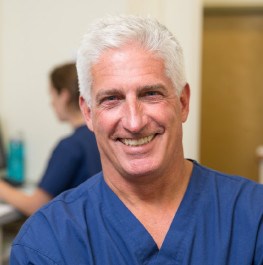Published by OSHEAN
Mako helps surgeons provide a more precise, accurate and personalized experience for patients undergoing total hip, total knee, and partial knee joint replacement surgery. It combines both sophisticated hardware (the actual robotic arm) and an advanced software application that programs the robotics for each type of surgery. A pre-op CT scan of the patient’s hip or knee, along with information from arrays that are placed on the patient in the operating room, create a 3-D image of the joint that can be examined from every angle on a monitor to assist the surgeon in performing the joint
replacement surgery.

In 2010, when Dr. Robert Marchand and his colleagues at South County Orthopedics (now Orthopedics RI – South County)/SCH began using Mako robotic-assisted technology, it was a breakthrough for hip replacement and partial
knee replacement. The technology was recently adapted and approved for robotic-assisted total knee replacement, and in June of 2016, SCH became one of the seven sites selected to do a study of robotic-assisted technology in total knee replacement. The study evaluated different ways of performing the surgery, efficiencies from a flow / mechanical / OR set-up / patient positioning perspective, and more.
As part of this process, Dr. Marchand completed clinical trials of 35 Mako robotic-assisted total knee replacements. The procedures were recorded start to finish as study creators attempted to develop a learning curve, including how long the procedures took to complete, the timing of every step, etc., in order to develop a pattern for the most efficient way to perform the procedures. Once the study was completed, SCH had the opportunity to purchase the new commercial software application, which would enable the robotic arm already being utilized for SCH’s robotic
partial knee and hip joint replacement surgeries to do full knee replacements.
During the fall of 2016, Dr. Marchand officially launched the world’s first commercial release of the robotic full knee replacement procedure and started surgeries on patients outside of the study. The team has now done about 600
Mako-assisted robotic total knees, and the orthopedic surgeons at South County have performed about 6,000 total joint replacement procedures with Mako robotic-assisted technology to date.
USING VIRTUAL SURGERIES TO EXPAND ROBOTIC-ASSISTED TRAINING
Due to the fact that Dr. Marchand and the team at SCH have become leaders in this field and have done such a large number of robotic-assisted orthopedic procedures, SCH has welcomed many colleagues from locations throughout the U.S. and the world, including Australia, China, Germany and Italy, among others, who have come to watch these surgeries to learn and observe the new robotic-assisted procedures first hand. However, a surgeon’s time is precious and it can be difficult for them to be away from their patients for several days at a time, and there is a limit to how many can be in the OR to observe a live surgery.
To address this, the SCH team, in conjunction with Stryker Mako, has now created another way for surgeons to observe Mako roboticassisted surgeries in real-time by outfitting an OR with cameras and microphones to create “virtual surgeries.” These virtual surgeries can be viewed through multiple different camera angles and participants can interact with the surgeon live to ask technical questions. They can be simultaneously streamed to a conference room in Mississippi, California or beyond.

Every detail counts when live streaming a procedure as detailed as orthopedic surgery and SCH relies on OSHEAN’s redundant Internet connection to provide the high-quality network connection needed for these live streaming events. OSHEAN’s Beacon 2.0 network, one of the most advanced optical networks in the country, provides OSHEAN members such as SCH with a highly manageable, highly redundant, standardsbased platform for a true service provider-grade network.
Virtual surgeries from SCH are now streamed on average of once a week. Instead of being able to have only one surgeon participate in a live OR, virtual surgeries expand the training opportunity to multiple surgeons as well as hospital administrators, at the same time and in the same room, providing multiple benefits. For example, many surgeons would naturally welcome the chance to have access to the latest in surgical technology such as Mako, but some hospital administrators may not immediately understand the value proposition of the technology. Hospital administrator personnel are not credentialed to be in the OR during a live surgery, but now with Mako, they’re given the ability to experience the surgery virtually along with multiple surgeons at different skill levels providing an excellent opportunity for all to ask questions, interact and learn about the technology and tools.
From an educational perspective, this is tremendously valuable.
